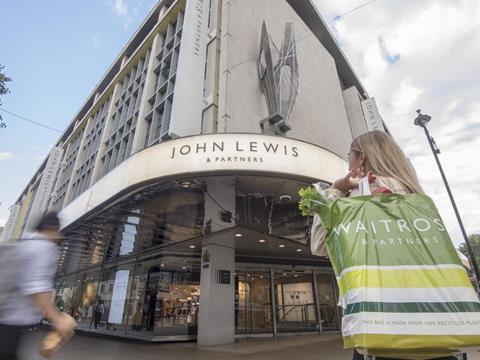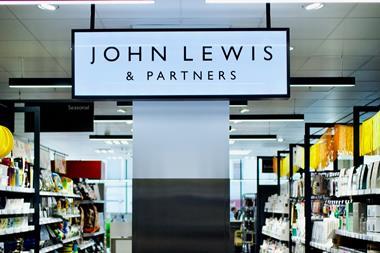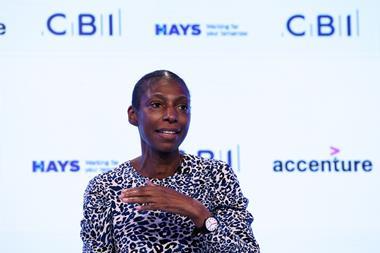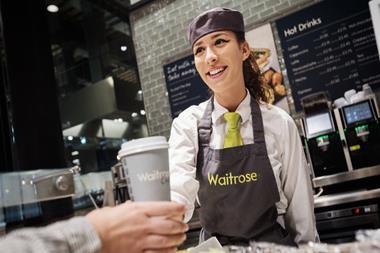
Top story
The John Lewis Partnership has plunged to a £234m loss on property writedowns and a drop in core profitability at both retail brands, while warning of future job cuts and declining to pay a staff bonus.
Total partnership sales in the year to 28 January were down 2% to £12.25bn, despite the wider inflationary environment driving higher prices.
Waitrose sales were down 3% to £7.31bn, while John Lewis sales edged up 0.2% to £4.94bn.
The group reported a loss before exceptional items and tax of £78m, down from profit of £181m last year, which it said was principally due to economic backdrop and inflationary pressures.
It said the impact of inflation was felt across the business, adding £179m to costs in the year.
Its overall loss before tax ballooned to £234m from a loss of £27m last year, largely due to property writedowns.
During the year, it closed two Waitrose branches and also reduced the space at both its Bracknell and London offices, while it recorded a net impairment charge for the year of £113m against the value of its store estate.
Losses were also driven by Waitrose’s trading operating profit declining by £126m (including £29m of cost savings delivered during the year), while John LewisTrading operating profit declining by £82m (including £47m of savings).
Waitrose saw a 3% drop in like-for-like sales, equating to a reduction in market share from 5.0% to 4.7%.
Profits were constrained by challenging trading dynamics, inflation pressure and one-off cost inefficiencies, partially offset by cost savings and profit growth from new propositions.
Despite customer numbers increasing by 7% in the year, sales volumes were down 10% in the year as it came off strong Online sales last year and saw a consumer shift to convenience. Additionally, basket sizes were down 15% in shops and consumers switched to lower-priced products.
Online sales this year represented just over 14% of Waitrose sales at average orders per week of 168k, compared to 17% last year at average weekly orders of 213k.
“As a consequence of low consumer confidence, pressure on household incomes amid the cost of living crisis, we have seen customers trading down to cheaper ranges; seeking to make their money go further and shifting their purchase behaviour with smaller baskets but more frequent shopping,” it stated.
Meanwhile, John Lewis sales for the year were up £16m (0.3%) on a like-for-like basis with last year with market share maintained and volumes up 1%.
After two challenging years for its physical shops, it saw a return of footfall (up 34% like-for-like on last year) and sales. Footfall to our shops grew 34% (reaching 100 million for the first time since before Covid), while online traffic was down 5% on last year (albeit more than half a billion visits to online channels).
In combination, this led to a channel mix rebalancing from pandemic levels of approximately 70:30 online/shops back to almost 60:40.
Chairman Sharon White said the figures made for “a tough set of results”.
She said she was “sorry” that the loss meant the group wouldn’t “be able to share a bonus this year or do as much as we would like on pay”.
She added: “As we need to become more efficient and productive, that will have an impact on our number of Partners. That’s a massive regret to me personally. It would be difficult enough in any business. It’s particularly tough in the Partnership, when everything we do is with one goal in mind: ‘happier people, happier business and happier world’.”
“Those of you who have been in the Partnership for a while will know that the business expanded rapidly between 2000 and 2015, going from 151 to 379 stores.We now have catch-up investment to make and have the potential to modernise the business at greater pace.”
“Given the economic backdrop, it would have been easy to step back from our principles where these carry a price tag. That is not the Partnership way. Instead we chose to invest in British farmers so they did not have to compromise on their high animal welfare standards.”
“Looking ahead, the external environment is no less uncertain. Even as headline inflation is starting to fall, the Partnership is still seeing costs rise.”
Faced with a more challenging environment, she said the group had adapted its plan to improve the profitability of the business, tripling its target for efficiency savings from £300m to £900m (by January 2026).
“The mantra for the year is cost out, margins up and customer focus,” she said.
Morning update
Deliveroo has made “excellent progress” on path to profitability, it said this morning, delivering positive adjusted EBITDA the second half of 2022 ahead of schedule.
Posting its annual results this morning, the delivery giant said 2022 had been a “a strong year of operational and financial performance” despite a challenging environment.
It highlighted a major achievement in reaching adjusted EBITDA profitability in the second half of the year (with growth of £6.6m compared to an £84.6 loss in the same period last year), which was well ahead of previous guidance that the group would reach this point in the second half of 2023 or first half of 2024.
The move to half year profitability was driven by the optimisation of consumer fees, efficiencies in its logistics network and the optimisation of marketing spend, despite investment in its consumer proposition at the same time.
Gross transaction value grew to £6.85bn in the year, an increase of 9%, or 7% in constant currency.
Orders increased by 5% to 299.2 million in 2022. year-on-year order growth slowed during the year from 19% in Q1 to 4% in Q2, 2% in Q3, and down 2% in Q4.
However GTV per order rose to £22.9, up 70p versus 2021, an increase of 3%, or 2% in constant currency, accelerating through the year driven by item level price inflation and optimisation of consumer fees.
Revenues grew 14% in the year to £1.97bn – ahead of the 9% growth rate in GTV, reflecting an increase in the revenue take rate.
Total adjusted EBITDA loss more than halved to £45m million from £100m in 2021, driven by a 250 bps increase in gross profit margin (as % of GTV) and a 40 bps improvement in marketing and overheads costs (as a % of GTV).
Looking forwards, 2023 GTV growth anticipated to be low-to-mid-single digits (in constant currency), with growth in Q1 expected to be broadly flat and improving through the year as the comparison base eases.
2023 adjusted EBITDA expected to continue to improve and to be in the range of £20m-£50m, weighted to the second half.
Will Shu, founder and CEO of Deliveroo, said: “I’m proud of our performance in the past 12 months. Our team has delivered in difficult market conditions, with continued growth and share gains in our key markets. I’m particularly pleased that the company reached adjusted EBITDA profitability in the second half of last year. This is a significant step on our path to sustainable cash generation, and we achieved this milestone a year earlier than our guidance by executing our strategy successfully despite headwinds from the market environment.
“The macroeconomic outlook for the year ahead remains uncertain, but our record in the past 12 months makes me optimistic about our ability to adapt and continue to deliver on our plans to drive profitable growth. I want to thank the whole Deliveroo team and our consumers, riders and merchants for their ongoing commitment and I look forward to more progress together in 2023.”
Deliveroo shares have edged down 0.3% this morning to 89.2p.
On the markets this morning, the FTSE 100 has rebounded 0.7% to 7,400.1pts.
Risers this morning include Ocado, up 4.5% to 444.3p, Virgin Wines, up 4.4% to 47p and McBride, up 2.3% to 26.7p.
Fallers include Bakkavor, down 3.7% to 104p, Finsbury Food Group, down 1.5% to 96p and Hotel Chocolat, down 1% to 194p.
Yesterday in the City
The budget yesterday did little to improve sentiment on UK markets as the FTSE 100 plunged 3.8% back to 7,344.5pts amid concerns over a potential banking crisis.
Grocery fallers included THG, down 7.7% to 56.9p, Marks & Spencer, down 6.5% to 145.4p, Just Eat Takeaway.com, down 6.2% to 1,566.4p, Naked Wines, down 5.4% to 91p, Deliveroo, down 4.7% to 89.5p, DS Smith, down 4.6% to 304.6p, Associated British Foods, down 4.5% to 1,900p and B&M European Value Retail, down 4.3% to 464.1p.
The day’s few risers included Domino’s Pizza Group, up 1.9% to 270.6p, Glanbia, up 1% to €13.08, Finsbury Food Group, up 1% to 97.5p, Haleon, up 1% to 318.5p and Cranswick, up 0.7% to 2,964p.



















No comments yet